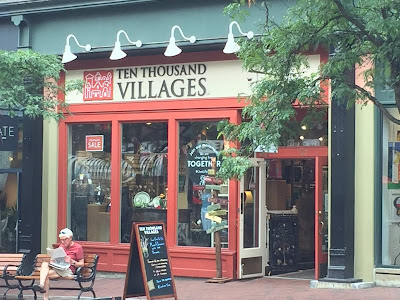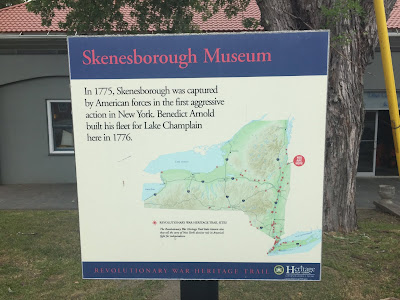New England: Blending Old with New
On our recent trip to New England, it was both a return to 'home' and a visit to a new place. I spent every summer in Connecticut and Maine when I was a child. My best friend had a cabin in Maine, and my first visit came when I was 9 years old. My parents had a cabin in Connecticut that I went to every summer until well into my 40's. That being said, those cabins were in the western parts of their respective states. This trip took us along the coast; a new territory for me to explore.
As it is when one returns home, Larry and I were on the lookout for the familiar, and it came out in comments such as; "that house looks like Connecticut", or "yep, that's something you'll only see in New England". But our trip wasn't about 'going home'. It was to see a new side to the familiar.
Colonial New England can be found throughout. The houses that were built 200 years ago and are still lived in today, aren't museum pieces, but they are a testament to the respect we have for our history. However, take a ride through coastal towns and those old houses, and the accompanying historic signs remind you, This is where America began!
The sign above is just up the street from this old house located in Castine, Maine; one of the oldest towns in New England.
Visit Philadelphia or Boston and you will be introduced to Revolutionary history. But visit the coast and you will be walking the paths first trod by those hearty and intrepid colonists who braved the ocean in little ships. (The Mayflower was only 110 feet long. By comparison, today's Royal Clipper Sailing Ship--a small luxury sailing cruise ship--is 442 feet long.)
"This lot bounded by Middle or King St. and LeBaron Alley was once owned by Dr. Samuel Fuller of the Mayflower and was given by his wife and son to the First Church for the use of the minister."
Though never huge, Plymouth Rock is smaller than it once was, because people have chipped away at it. The historic rock is now protected in this monument built above it. A park ranger answers questions and explains how the Pilgrims landed here instead of in New York, after going off course. Their trip took them twice as long as expected, and winter was getting close, so the Pilgrims lived on the ship through the winter. The boats, used to carry men to shore for hunting and exploring, tied up to the rock and used it as a landmark.
 |
| The Monument protecting Plymouth Rock |
Historic towns are not the only interesting places to visit in New England. When we were in Burlington, Vermont, we had the pleasure of going downtown to the renewed and updated Church Street district, just blocks from the pier on Lake Champlain. Church Street has been turned into a pedestrian mall, with wonderful shops and great restaurants in a delightful atmosphere.
A beautiful old church appropriately anchors one end of the Church Street Open-Air Mall.
You won't find big name chain stores along this mall, but there were lots of interesting local shops such as this Fair Trade Store, Ten Thousand Villages, a non-profit store that markets hand crafted products made by artisans in developing countries. A Fair Trade Store sells only items made or grown in other countries where the workers are guaranteed a fair wage, and often some sort of savings plan so that they can grow use their profits to grow their business.
Outdoor cafes, interesting artwork and sculptures dotted the sidewalks. Larry discovered a chair lift bench just waiting to give his feet a rest.
The Visitor's Center houses a very nice museum sharing the town's history.
A diorama showed Skenesborough, later renamed Whitehall, in its earliest days. This section shows the eight ships under construction. Arnold supervised construction of the ships and later commanded the small fleet. They lost the battle, but caused enough damage to British ships that when the British came back the next year, we were ready. Whitehall is considered the Birthplace of the American Navy.
Interesting Fact.: There is a document in the Library of Congress that declares Whitehall as the Birthplace of the U. S. Navy. However, Whitehall is not alone in making this claim. There are at least 5 places that believe they are the birthplace!
The museum also houses the remains of the first USS Ticonderoga, a wooden steamship built in Vermont, that fought in the War of 1812 on Lake Champlain.
USS Ticonderoga: The remains of the original ship is mostly just the keel, the bottom boards that framed the hull. Below is a model of the original ship. Five Naval ships have been named USS Ticonderoga since this first one.The shipyard builds or restores old style wooden sailing ships. While we were there, the Mayflower II had been brought in from its port in Plymouth, Massachusetts, to be restored. Wooden ships rot. The original ships may have only lasted 8-10 years. Mystic seaport is dedicated to using as many tools and methods as shipbuilders would have used 400 years ago.
Walking through the village, we were treated to demonstrations. Here the whalers are demonstrating the techniques used to catch whales and bring them to the ship.
Mystic Seaport is a step back in time, but just down the coast on the Thames River is the town of Groton, home of the Submarine Force Museum, and the USS Nautilus, the Navy's first Nuclear submarine.
Learning about a sailors life aboard a ship is always fascinating, but submarines take it to a whole different level. It's amazing how well they function in such close, tight quarters.
Sleeping Quarters for 10!
Officers had it better!
It was hard finding a place to jump in at the Cabot Cheese Tasting table! And of course, we came out with some new flavors of cheese.
Ben and Jerry's was a fun tour with some Chunky Monkey at the end. Their Action Station booth outside fills visitors in on current political and environmental projects they are involved in. Climate change is a big focus.
Mashed apples are placed in layers on these press boards. 15 boards are stacked, and raised into the press, squeezing the juice out.
The solar field behind Cold Hollow Cider Mill
My final two photos epitomize New England past and present.
 |
| Gold Brook Covered Bridge |
Solar Fields, or sun fields as one place dubbed them, have sprung up throughout the region. Many are small and power local businesses. But we spied them in power plants, and in fields like this one, which was one of the largest we saw. A view into tomorrow.
New England: Where the past blends with the future.










































No comments:
Post a Comment